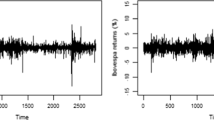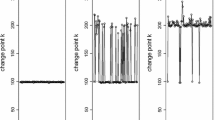Abstract
Market microstructure noise is a challenge to high-frequency based estimation of the integrated variance, because the noise accumulates with the sampling frequency. This has led to widespread use of constructing the realized variance, a sum of squared intraday returns, from sparsely sampled data, for example 5- or 15-minute returns. In this paper, we analyze the impact of microstructure noise on the realized range-based variance and propose a bias correction to the range-statistic. The new estimator is shown to be consistent for the integrated variance and asymptotically mixed Gaussian under simple forms of microstructure noise. We can select an optimal partition of the high-frequency data in order to minimize its asymptotic conditional variance. The finite sample properties of our estimator are studied with Monte Carlo simulations and we implement it using Microsoft high-frequency data from TAQ. We find that a bias-corrected range-statistic often leads to much smaller confidence intervals for the integrated variance, relative to the realized variance.
Similar content being viewed by others
References
Aït-Sahalia, Y.: Disentangling diffusion from jumps. J. Financ. Econ. 74, 487–528 (2004)
Aït-Sahalia, Y., Mykland, P.A., Zhang, L.: How often to sample a continuous-time process in the presence of market microstructure noise. Rev. Financ. Stud. 18, 351–416 (2005)
Aït-Sahalia, Y., Mykland, P.A., Zhang, L.: Ultra high frequency volatility estimation with dependent microstructure noise. Working paper, Princeton University (2006). Available at http://www.princeton.edu/~yacine/
Aldous, D.J., Eagleson, G.K.: On mixing and stability of limit theorems. Ann. Probab. 6, 325–331 (1978)
Alizadeh, S., Brandt, M.W., Diebold, F.X.: Range-based estimation of stochastic volatility models. J. Finance 57, 1047–1092 (2002)
Andersen, T.G., Benzoni, L., Lund, J.: An empirical investigation of continuous-time equity return models. J. Finance 57, 1239–1284 (2002)
Andersen, T.G., Bollerslev, T., Diebold, F.X., Labys, P.: Great realizations. Risk 13, 105–108 (2000)
Back, K.: Asset prices for general processes. J. Math. Econ. 20, 371–395 (1991)
Bandi, F.M., Russell, J.R.: Microstructure noise, realized variance, and optimal sampling. Rev. Econ. Stud. 75, 339–369 (2008)
Barndorff-Nielsen, O.E., Graversen, S.E., Jacod, J., Podolskij, M., Shephard, N.: A central limit theorem for realized power and bipower variations of continuous semimartingales. In: Kabanov, Y., Lipster, R., Stoyanov, J. (eds.) From Stochastic Calculus to Mathematical Finance: The Shiryaev Festschrift, pp. 33–68. Springer, Berlin (2006)
Barndorff-Nielsen, O.E., Hansen, P.R., Lunde, A., Shephard, N.: Designing realised kernels to measure the ex post variation of equity prices in the presence of noise. Econometrica 76(6), 1481–1536 (2008)
Barndorff-Nielsen, O.E., Hansen, P.R., Lunde, A., Shephard, N.: Subsampling realised kernels. J. Econom. (2008, forthcoming). Available at http://www.nuffield.ox.ac.uk/users/shephard/
Barndorff-Nielsen, O.E., Shephard, N.: Econometric analysis of realized volatility and its use in estimating stochastic volatility models. J. R. Stat. Soc. Ser. B 64, 253–280 (2002)
Barndorff-Nielsen, O.E., Shephard, N.: Econometric analysis of realized covariation: High frequency based covariance, regression, and correlation in financial economics. Econometrica 72, 885–925 (2004)
Barndorff-Nielsen, O.E., Shephard, N.: Power and bipower variation with stochastic volatility and jumps. J. Financ. Econom. 2, 1–48 (2004)
Barndorff-Nielsen, O.E., Shephard, N.: Econometrics of testing for jumps in financial economics using bipower variation. J. Financ. Econom. 4, 1–30 (2006)
Brandt, M.W., Diebold, F.X.: A no-arbitrage approach to range-based estimation of return covariances and correlations. J. Bus. 79, 61–73 (2006)
Christensen, K., Podolskij, M.: Range-based estimation of quadratic variation. Working paper, Aarhus School of Business (2006). Available at http://www.math.ethz.ch/~podolski/
Christensen, K., Podolskij, M.: Realized range-based estimation of integrated variance. J. Econom. 141, 323–349 (2007)
Delattre, S., Jacod, J.: A central limit theorem for normalized functions of the increments of a diffusion process, in the presence of round-off errors. Bernoulli 3, 1–28 (1997)
Doornik, J.A.: Object-Oriented Matrix Programming Using Ox, 3 edn. Timberlake Consultants Press (2002)
Fang, Y.: Volatility modeling and estimation of high-frequency data with Gaussian noise. PhD thesis, Sloan School of Management, MIT (1996). Unpublished
Garman, M.B., Klass, M.J.: On the estimation of security price volatilities from historical data. J. Bus. 53, 67–78 (1980)
Ghysels, E., Harvey, A.C., Renault, E.: Stochastic volatility. In: Maddala, G.S., Rao, C.R. (eds.) Handbook of Statistics, vol. 14, pp. 119–191. North-Holland, Amsterdam (1996)
Gloter, A., Jacod, J.: Diffusions with measurement errors, I: local asymptotic normality. ESAIM: Probab. Stat. 5, 225–242 (2001)
Gloter, A., Jacod, J.: Diffusions with measurement errors, II: measurement errors. ESAIM: Probab. Stat. 5, 243–260 (2001)
Griffin, J.E., Oomen, R.C.A.: Covariance measurement in the presence of non-synchronous trading and market microstructure noise. Working paper, University of Warwick (2006). Available at http://www.kent.ac.uk/ims/personal/jeg28/
Hansen, P.R., Lunde, A.: Realized variance and market microstructure noise. J. Bus. Econ. Stat. 24, 127–161 (2006)
Hayashi, T., Yoshida, N.: On covariance estimation of non-synchronously observed diffusion processes. Bernoulli 11, 359–379 (2005)
Huang, X., Tauchen, G.: The relative contribution of jumps to total price variance. J. Financ. Econom. 3, 456–499 (2005)
Jacod, J.: Limit of random measures associated with the increments of a Brownian semimartingale. Preprint number 120, Laboratoire de Probabilitiés, Université Pierre et Marie Curie, Paris (1994)
Jacod, J.: On continuous conditional Gaussian martingales and stable convergence in law. Séminaire de Probabilités XXXI, LNM 1655, 232–246 (1997)
Jacod, J., Protter, P.E.: Asymptotic error distributions for the Euler method for stochastic differential equations. Ann. Probab. 26, 267–307 (1998)
Jacod, J., Shiryaev, A.N.: Limit Theorems for Stochastic Processes, 2nd edn. Springer, Berlin (2003)
Jiang, G.J., Oomen, R.C.A.: Testing for jumps when asset prices are observed with noise—a “swap variance” approach. J. Econom. 144, 352–370 (2008)
Kalnina, I., Linton, O.: Estimating quadratic variation consistently in the presence of correlated measurement error. J. Econom. 147, 47–59 (2008)
Large, J.: Estimating quadratic variation when quoted prices change by a constant increment. Working paper, All Souls College, University of Oxford (2006). Available at http://www.economics.ox.ac.uk/members/jeremy.large/
Mancini, C.: Estimation of the characteristics of jump of a general jump-diffusion. Scand. Actuar. J. 2004(1), 42–52 (2004)
Martens, M., van Dijk, D.: Measuring volatility with the realized range. J. Econom. 138, 181–207 (2007)
Oomen, R.C.A.: Properties of bias-corrected realized variance under alternative sampling schemes. J. Financ. Econom. 4, 555–577 (2005)
Parkinson, M.: The extreme value method for estimating the variance of the rate of return. J. Bus. 53, 61–65 (1980)
Podolskij, M., Vetter, M.: Estimation of volatility functionals in the simultaneous presence of microstructure noise and jumps. Working paper, CREATES, University of Aarhus and Ruhr University of Bochum, Bernoulli (2007, to appear)
Protter, P.E.: Stochastic Integration and Differential Equations, 1st edn. Springer, Berlin (2004)
Rényi, A.: On stable sequences of events. Sankhya: Indian J. Stat. Ser. A 25, 293–302 (1963)
Rogers, L.C.G., Satchell, S.E.: Estimating variances from high, low, and closing prices. Ann. Appl. Probab. 1, 504–512 (1991)
Sheppard, K.: Realized covariance and scrambling. Working paper, University of Oxford (2006). Available at http://www.cireq.umontreal.ca/activites/060423/Papiers/Sheppard.pdf
Zhang, L.: Efficient estimation of stochastic volatility using noisy observations: a multi-scale approach. Bernoulli 12, 1019–1043 (2006)
Zhang, L., Mykland, P.A., Aït-Sahalia, Y.: A tale of two time scales: determining integrated volatility with noisy high-frequency data. J. Am. Stat. Assoc. 100(472), 1394–1411 (2005)
Author information
Authors and Affiliations
Corresponding author
Additional information
We should like to thank an anonymous referee and the associate editor for insightful comments on an earlier draft. Parts of this paper were written while Kim Christensen was at the University of California, San Diego, whose hospitality is gratefully acknowledged. Mark Podolskij received financial support from CREATES funded by the Danish National Research Foundation, and Mathias Vetter was supported by the Deutsche Forschungsgemeinschaft grant SFB 475 “Reduction of Complexity in Multivariate Data Structures.” The code for this paper was written in the Ox programming language, due to Doornik (2002). All views expressed here are those of the authors and do not necessarily represent the views of Nordea.
Rights and permissions
About this article
Cite this article
Christensen, K., Podolskij, M. & Vetter, M. Bias-correcting the realized range-based variance in the presence of market microstructure noise. Finance Stoch 13, 239–268 (2009). https://doi.org/10.1007/s00780-009-0089-9
Received:
Accepted:
Published:
Issue Date:
DOI: https://doi.org/10.1007/s00780-009-0089-9
Keywords
- Bias correction
- Integrated variance
- Market microstructure noise
- Realized range-based variance
- Realized variance




